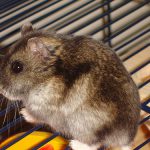The winter white Russian is a very similar hamster to the
Campbell’s Russian.Appearance
Winter white Russian dwarf hamsters, also known as Siberian hamsters, are generally a dark gray color with a black dorsal stripe along the length of their back, and furred feet. They have a white belly, while in the winter the fur on their back can turn to a dark brown, or sometimes a pale brown. There are also a few lighter color variations available such as pearl, sapphire and sapphire pearl.
They can be similar in appearance to Campbell’s Russians and may be mislabelled in pet stores, but Campbell’s Russians are more common.
Size
Adult winter white Russians tend to be around 3.5 to 4 inches in length. Like other dwarf hamsters, their small size, as well as their speed and agility, can make them hard to handle for young children.
Expected Life Span
A winter white Russian dwarf hamster can be expected to live for between 1.5 and 2 years, the same as a Campbell’s Russian. Both of these dwarf species therefore have a much shorter life span than other types of hamster.
Care
Winter white Russians, like Campbell’s Russians, are generally friendly but they are not as tame as the Syrian hamster and have a reputation for nipping when nervous or roughly handled. They should therefore not be handled by small children.
Despite their small size, they are extremely active and so should be housed in as large a habitat as possible to give them the space they need to prevent boredom. A solid sided cage or an aquarium would be the most suitable choice of housing as they are small enough to squeeze through the bars of most wire hamster cages.
They can normally be safely housed with other winter white Russians if kept in same-sex pairs or small groups, but if you do want to house more than one together then they will need to be introduced at a young age. Even then, it is still possible that the hamsters need to be separated after they mature. New hamsters should never be introduced to a group.
Some lines of winter white Russians are at a higher risk of diabetes, therefore it is best to avoid feeding them fruit or sugary treats.


